 W
WThe ʻakekeʻe is a bird species in the family Fringillidae, where it is placed in the Hawaiian honeycreeper genus Loxops. It is endemic to the island of Kauaʻi where it is found in small numbers in higher elevations. Because of their similar size, shape, and unusual bill, the ʻakekeʻe and the ʻakepa were for some time classified as a single species. This was eventually changed, because of differences in their color, nesting behavior, and calls.
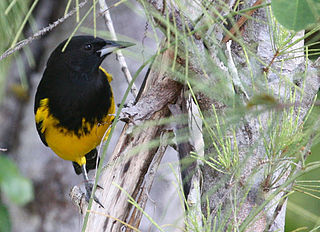 W
WThe Bahama oriole is a species of songbird in the New World blackbird family - Icteridae. It is endemic to the Bahamas. It is listed as critically endangered by the IUCN (CR). The taxon was originally classified as its own distinct species in 1890 by Joel Asaph Allen before it was lumped with the Cuban oriole, Hispaniolan oriole, and Puerto Rican oriole into a single species by the ornithologist James Bond in his book "Birds of the West Indies". It wasn't until 2010 that all four birds were again elevated to full species status based on a combination of evidence from DNA, plumage and song. Since it was not recognized as a distinct species for so long, the Bahama oriole's preferred non-breeding season habitat is unknown and current estimates of its exact numbers remain vague.
 W
WThe bamboo warbler or bamboo scrub-warbler is a species of Old World warbler in the family Locustellidae. It is found in Democratic Republic of the Congo, Ethiopia, South Sudan, Tanzania, Uganda, and Zambia. Its natural habitats are subtropical or tropical moist montane forests and subtropical or tropical moist shrubland.
 W
WBelford's melidectes, also known as Belford's honeyeater, is a species of bird in the family Meliphagidae. It is found in New Guinea. Its natural habitat is subtropical or tropical moist montane forest.
 W
WThe black shama is a species of bird in the family Muscicapidae. It is endemic to the island of Cebu, Philippines.
 W
WThe blue-capped ifrit, also known as the blue-capped ifrita, is a small and insectivorous passerine species currently placed in the monotypic family, Ifritidae. Previously, the ifrit has been placed in a plethora of families including Cinclosomatidae or Monarchidae. Blue-capped ifrits are considered an ancient relict species endemic to New Guinea. This corvoid species originally dates back to the Oligocene epoch, on a series of proto-Papuan islands, with minimal known evolutionary divergences.
 W
WCabanis's spinetail is a species of bird in the family Furnariidae. The common name and Latin binomial commemorates the German ornithologist Jean Louis Cabanis.
 W
WThe red satinbird, antenna satinbird or crested cnemophilus, formerly known as the sickle-crested bird-of-paradise is a species of bird in the family Cnemophilidae. It was formerly placed in the bird-of-paradise family Paradisaeidae until genetic work proved it was unrelated to those birds. It is found in Papua New Guinea.
 W
WThe dimorphic dwarf kingfisher is a species of bird in the family Alcedinidae that is endemic to the central and southern Philippines. Its natural habitat is subtropical or tropical moist lowland forests.
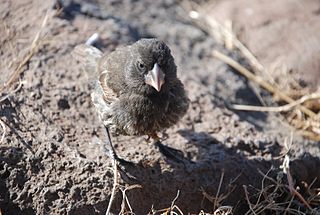 W
WThe Española cactus finch, is a species of bird in the tanager family Thraupidae. It is one of Darwin's finches, and is endemic to the Galápagos islands, where it is restricted to Española, Genovesa, Darwin and Wolf Islands. This rather dark bird resembles the smaller and finer-beaked common cactus finch, but the two species do not co-inhabit any island.
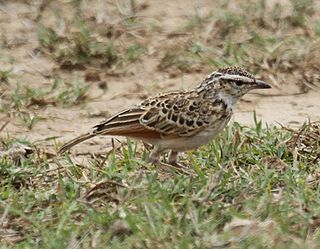 W
WThe foxy lark or Abyssinian lark is a species of lark in the family Alaudidae. It is found in east-central Africa.
 W
WThe grey-striped spurfowl is a species of bird in the family Phasianidae. It is found only in Angola.
 W
WThe Hood mockingbird, also known as the Española mockingbird, is a species of bird in the family Mimidae. It is endemic to Española Island in the Galápagos Islands, Ecuador, and it is one of four closely related mockingbird species endemic to the Galápagos archipelago. It is found in dry forests and is omnivorous, though it primarily is a carnivore or scavenger. The species has a highly territorial social structure and has no fear of humans. It is the only species of Galápagos mockingbird that Charles Darwin did not see or collect on the voyage of the Beagle.
 W
WThe hooded cuckooshrike is a species of bird in the family Campephagidae. It is found in the New Guinea Highlands.
 W
WJameson's antpecker is a songbird species found in central Africa. Like all antpeckers, it is tentatively placed in the estrildid finch family (Estrildidae). It has traditionally been included as a subspecies of P. rubrifrons and the common name Jameson's antpecker was sometimes used for both taxa. But today, they are often considered distinct species.
 W
WJameson's wattle-eye is a species of bird in the family Platysteiridae. It is found in Democratic Republic of the Congo, Kenya, South Sudan, Tanzania, and Uganda. Its natural habitats are subtropical or tropical moist lowland forests and subtropical or tropical moist montane forests.
 W
WThe Lānaʻi ʻalauahio was found on much of the island of Lana'i in the Hawaiian archipelago. It apparently was common until the early 1900s, when there appeared to have been a steep decline in birds on the island. It was similar to the Maui alauahio and this species may have reacted similarly to its existing relative, to which it was considered conspecific. This bird was one of several to vanish from Lana'i, along with others such as the Lanai hookbill.
 W
WThe Landana firefinch, also known as the pale-billed firefinch, is a species of estrildid finch found in central Africa. It has an estimated global extent of occurrence of 100,000 km2. It occurs mainly in southern Gabon and the Republic of Congo; as well as in western Democratic Republic of the Congo and in extreme northwestern Angola. The IUCN has classified the species as being of least concern.
 W
WThe Laysan finch is a species of Hawaiian honeycreeper, that is endemic to the Northwestern Hawaiian Islands. It is one of four remaining finch-billed Hawaiian honeycreepers, and is closely related to the smaller Nihoa finch. The Laysan finch is named for Laysan, the island to which it was endemic on its discovery. It was subsequently introduced to a few other atolls, and its historical range included some of the main islands.
 W
WMacGregor's bowerbird is a medium-sized, up to 26 cm long, olive brown bowerbird of New Guinea's mountain forests, roughly the size and shape of an American Robin or a Eurasian Blackbird. The male is adorned with an erectile orange yellow crest, that is partly hidden until shown in courtship display. The unadorned female is similar to the male, but without the crest. Superb mimics, they are known for imitating other birds, pigs, rushing water, and even human speech.
 W
WThe maroon-naped sunbird is a species of bird in the family Nectariniidae. It is endemic to the Philippines. Its natural habitat is subtropical or tropical moist lowland forests.
 W
WThe medium tree finch is a critically endangered species of bird in the Darwin's finch group of the tanager family Thraupidae. It is endemic to the Galápagos Islands where it is only found on Floreana Island. Its name is derived from the fact that the bird's beak is intermediate in size between that of the small tree finch and the large tree finch. Because it has a very small range on a single island, and because of the introduction of a parasitic fly which kills the nestlings, the International Union for Conservation of Nature has rated the medium tree finch as "critically endangered".
 W
WThe Mindanao pygmy babbler is a bird species endemic to the Philippines. It had been placed in the family Timaliidae, but it is a close relative of the white-eyes however, and many taxonomists now place it in the family Zosteropidae.
 W
WThe naked-faced spiderhunter is a species of bird in the family Nectariniidae. It is endemic to the Philippines.
 W
WThe Noronha vireo is a species of bird in the family Vireonidae. It is endemic to the island of Fernando de Noronha, Brazil. It is found in woodland, shrubland and gardens. It has been considered conspecific with the chivi vireo in the past. However, it varies from the chivi vireo in that its plumage is significantly duller and the bill longer.
 W
WThe parrot-billed sparrow is found in the arid lowlands of eastern Africa. At 18 centimetres (7.1 in) and 42 grams (1.5 oz), it is the largest of the sparrows of the family Passeridae. It is often considered a subspecies of the grey-headed sparrow.
 W
WThe Patagonian tinamou also known as Ingouf's tinamou is a member of one of the most ancient groups of paleognath birds, the tinamous. This species is native to southern South America.
 W
WThe red-browed amazon is a species of parrot in the family Psittacidae. It is endemic to Atlantic Forest in eastern Brazil. It has been considered a subspecies of the blue-cheeked amazon, but today all major authorities consider them separate species. It is threatened both by habitat loss and by being captured for the trade in wild parrots.
 W
WThe rufous-tailed stipplethroat or rufous-tailed antwren is a species of insectivorous bird in the antbird family Thamnophilidae. It was formerly placed in the genus Myrmotherula. It is found in Brazil, Colombia, Ecuador, and Peru. Its natural habitat is subtropical or tropical moist lowland forests.
 W
WShelley's starling is a species of starling in the family Sturnidae. It is found in East Africa, within the borders of Ethiopia, Kenya, Somalia, South Sudan, and Tanzania.
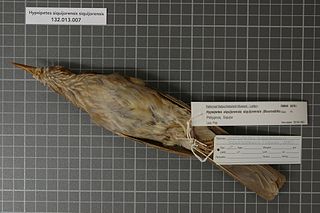 W
WThe streak-breasted bulbul, is a songbird species in the bulbul family, Pycnonotidae.
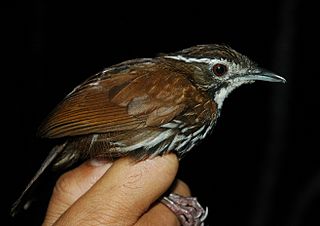 W
WThe striated wren-babbler is a species of passerine bird in the family Pellorneidae. It is endemic to the Philippines. Its natural habitats are subtropical or tropical moist lowland forest and subtropical or tropical moist montane forest.
 W
WThe Taveta weaver, also known as the Taveta golden weaver, is a species of bird in the weaver family, Ploceidae. It is found on the African Savannah in Kenya and Tanzania. The name of the bird comes from the unique markings/coloration of the bird, as well as how these birds weave intricate nests.
 W
WThe Visayan broadbill is a species of bird in the family Eurylaimidae. It is endemic to the islands of Samar, Leyte and Bohol in the central Philippines. Its natural habitat is subtropical or tropical moist lowland forests. It is threatened by habitat loss.
 W
WThe white-winged robin is a species of bird in the family Petroicidae.
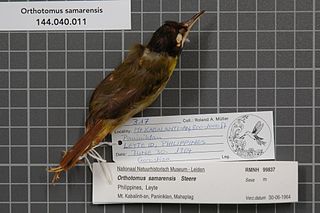 W
WThe yellow-breasted tailorbird is a species of passerine bird formerly placed in the "Old World warbler" assemblage, but now placed in the family Cisticolidae.